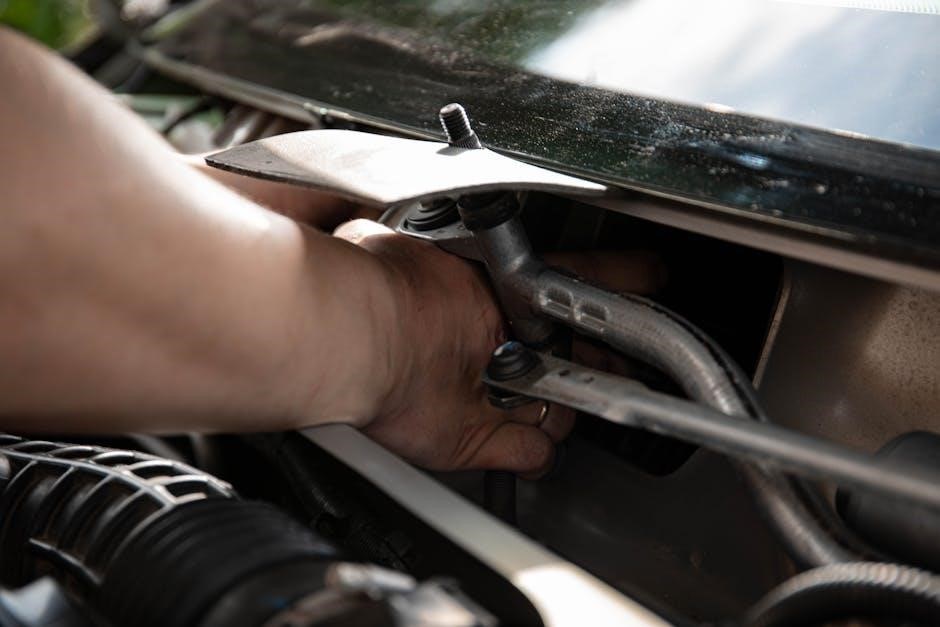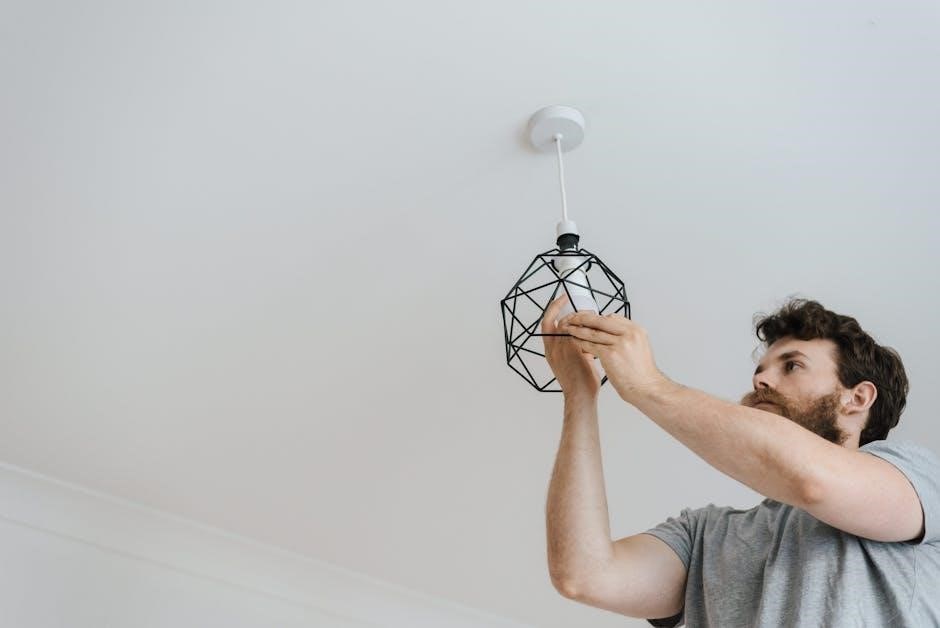Welcome to the Viper 5305V installation guide. This manual provides a comprehensive overview of the system, including its features, installation steps, and troubleshooting tips. Designed for professionals and DIY enthusiasts, it ensures a smooth setup process.
1.1 Purpose and Scope of the Manual
This manual is designed to guide users through the installation, configuration, and troubleshooting of the Viper 5305V remote start and alarm system. It provides detailed step-by-step instructions, wiring diagrams, and essential information for a successful setup. The scope covers system components, compatibility, and best practices for installation in various vehicles, including manual and automatic transmissions. The manual also addresses common issues and offers maintenance tips to ensure optimal performance. Intended for professionals and DIY enthusiasts, it serves as a comprehensive resource for understanding and working with the Viper 5305V system effectively.
1.2 Key Features of the Viper 5305V System
The Viper 5305V system offers advanced remote start and alarm functionality, ensuring convenience and vehicle security. Key features include a robust remote start with automatic temperature check, an immobilizer bypass for enhanced security, and compatibility with a wide range of vehicles. The system supports both manual and automatic transmissions, making it versatile for various setups. Additional features include remote lock/unlock, trunk release, and an integrated alarm with impact and motion sensors. The system’s failsafe start ensures safe engine operation, while its compact design simplifies installation. These features make the Viper 5305V a reliable choice for modern vehicle security and remote start needs.
1.3 Target Audience for the Installation Guide
This manual is designed for individuals installing the Viper 5305V system, including car enthusiasts, professional installers, and vehicle owners seeking to enhance their car’s security and functionality. It caters to those with basic knowledge of automotive electronics and tools. The guide is also useful for technicians in automotive shops and DIYers aiming to integrate advanced features into their vehicles. By following the manual, users can ensure a successful installation, whether they are professionals or hobbyists. The content is tailored to meet the needs of various skill levels, ensuring clarity and comprehensiveness for all users.

System Overview
The Viper 5305V is a cutting-edge security and remote start system designed for vehicles, offering advanced features like alarm protection, keyless entry, and engine immobilization. It ensures enhanced security, convenience, and control over your vehicle’s functions. Understanding the system’s components and capabilities is essential for proper installation and operation. This section provides a comprehensive overview of the Viper 5305V, helping users familiarize themselves with its design and functionality before proceeding with installation.
2.1 Components of the Viper 5305V System
The Viper 5305V system includes a control module, wiring harness, remote controls, and various sensors. The control module acts as the brain, processing inputs and commands. The wiring harness connects all components, ensuring seamless communication. Remote controls provide user interaction, while sensors monitor vehicle status. Additional components may include a siren, immobilizer, and integration modules. Each part is essential for the system’s functionality, ensuring security, convenience, and reliability. Proper identification and handling of these components are critical for successful installation and operation.
2.2 Compatibility with Vehicle Types
The Viper 5305V system is designed to be compatible with a wide range of vehicles, including cars, trucks, SUVs, and motorcycles, provided they have a 12-volt electrical system. It works with both gasoline and diesel engines, and its advanced features support modern vehicles with immobilizers. However, compatibility may vary depending on the vehicle’s make, model, and year. A bypass module may be required for vehicles equipped with an immobilizer system. Always consult the official Viper 5305V manual or the manufacturer’s website for specific compatibility details before installation.
2.3 Reference to the Official Viper 5305V Manual
For detailed instructions and specifications, refer to the official Viper 5305V installation manual. This document provides comprehensive guidance tailored specifically for your system, ensuring safe and accurate installation. It includes diagrams, wiring schematics, and troubleshooting tips. Always follow the manufacturer’s recommendations to avoid damage or malfunctions. If you don’t have a physical copy, download the manual from the official Viper website or request it from an authorized dealer. Adhering to the official manual guarantees compliance with the system’s design and ensures optimal performance. Consult it regularly for updates or clarifications during the installation process.

Pre-Installation Requirements
Brief overview of necessary steps before starting the installation, including gathering tools, vehicle preparation, and reviewing the wiring diagram to ensure a smooth process.
3.1 Tools and Materials Needed
To install the Viper 5305V system, you’ll need basic tools like screwdrivers, pliers, and wrenches. Additional items include wire strippers, a multimeter, and electrical tape for wiring. Ensure you have fasteners, adhesives, and mounting hardware for securing components. A drill and bits may be required for panel modifications. Refer to the official manual for specific tools tailored to your vehicle. Safety gear like gloves and safety glasses is recommended. Having all materials ready ensures a smooth installation process and minimizes delays. Organize your tools and materials beforehand for efficiency. Always follow safety guidelines when working with electrical systems.
3.2 Vehicle Preparation Steps
Before installing the Viper 5305V, ensure your vehicle is properly prepared. Disconnect the negative battery terminal to prevent electrical hazards. Locate the OBD-II port, typically under the steering column or in the glove compartment. Access the wiring harness and identify key wires using a wiring diagram specific to your vehicle. Remove trim panels or dash components to access installation areas. Test the vehicle’s current alarm and remote start systems to ensure they are disabled; Clean the mounting surfaces for components like the control module and remote start brain. Proper preparation ensures a safe and efficient installation process. Always refer to your vehicle’s manual for specific instructions or precautions.
3.3 Understanding the Wiring Diagram
The wiring diagram is a critical guide for installing the Viper 5305V system. It illustrates the vehicle’s electrical circuits and how they connect to the system. Start by identifying the battery, ignition, and starter wires, as these are essential for remote start functionality. Use the color-coded keys to match wires accurately. Ensure the immobilizer bypass is correctly integrated to prevent installation issues. Consult the diagram to locate the proper connections for features like door locks and trunk release. Double-check all wiring paths to avoid short circuits or incorrect connections. Always cross-reference the diagram with your vehicle’s wiring specifications to ensure compatibility and accuracy. Proper understanding of the wiring diagram is essential for a successful installation.

Step-by-Step Installation Guide
This section provides detailed instructions for installing the Viper 5305V system, including mounting the control module, connecting wires, and configuring features like remote start and alarm settings.
4.1 Mounting the Control Module
Mounting the control module is the first step in the installation process. Locate a suitable position, such as under the dashboard, ensuring it is secure and out of sight. Use screws or adhesive strips to fasten the module firmly. Avoid areas exposed to moisture or extreme temperatures. Ensure the module is level and accessible for future adjustments. Proper mounting prevents damage and ensures reliable system performance. Follow the manufacturer’s guidelines for optimal placement and stability. This step is critical for the overall functionality of the Viper 5305V system.
4.2 Connecting the Wiring Harness
Connecting the wiring harness requires precision to ensure proper functionality. Begin by identifying the wires using the color codes from the wiring diagram. Match the harness wires to the vehicle’s electrical system, connecting each terminal carefully. Use the provided connectors to secure the links. Avoid over-tightening, which may damage the wires. Route the harness neatly, ensuring it is not pinched or exposed to moving parts. Double-check all connections for accuracy and security. Proper wiring ensures reliable system operation and prevents electrical issues. Refer to the wiring diagram for specific instructions and verification.
4.3 Installing the Remote Start Feature
Installing the remote start feature involves connecting the remote start module to the vehicle’s ignition and starter circuits. Locate the ignition and starter wires using the wiring diagram. Connect the remote start module’s corresponding wires to these points, ensuring secure connections. Use the provided connectors to prevent soldering errors. Once connected, test the remote start functionality by pressing the remote’s start button. Verify that the engine starts and stops correctly. If issues arise, check the wiring connections and refer to the wiring diagram for clarification. Proper installation ensures reliable remote start operation and prevents potential electrical faults.
4.4 Configuring the Alarm System
Configuring the alarm system ensures all features work seamlessly with your vehicle. Begin by arming the system using the remote control and test each sensor’s functionality. Adjust the shock sensor sensitivity to prevent false triggers. Enable silent arming if desired. Program the auxiliary channels for additional accessories like trunk release. Use the remote to test door, hood, and trunk triggers. Ensure the alarm’s siren and LED indicators activate correctly. Review and customize settings like arming delays and anti-carjacking features. Proper configuration ensures reliable security and optimal performance of your Viper 5305V system.
4.5 Final Testing and Quality Check
Final testing and quality check are crucial to ensure the Viper 5305V system functions correctly. Start by testing the remote start feature, verifying the vehicle starts and runs smoothly. Check the alarm system by triggering sensors to confirm the siren and LED alerts activate. Test all wired and wireless remotes for consistent response. Inspect all connections for secure wiring and proper grounding. Ensure the immobilizer bypass integrates seamlessly with the remote start. Finally, review the installation for any overlooked steps and confirm all features operate as intended for reliable performance and security.

Wiring Diagram Explanation
The wiring diagram provides a visual guide for connecting components, ensuring proper installation. Color-coded wires and clear symbols simplify understanding the system’s electrical layout and connections.
5.1 Understanding the Wiring Color Codes
Understanding wiring color codes is crucial for a successful installation. Each wire in the Viper 5305V system is color-coded to indicate its specific function. For example, the red wire typically represents a constant 12V power source, while the yellow wire is often used for the starter circuit. The black wire usually signifies ground, and the green or blue wires may control alarm or remote start functions. Referencing the wiring diagram and matching colors carefully ensures proper connections and avoids system malfunctions. Always double-check the wiring diagram in the manual to confirm the correct function of each color-coded wire during installation.
5.2 Connecting the Starting Circuit
Connecting the starting circuit is essential for enabling remote start functionality. Identify the vehicle’s starter wire using the wiring diagram provided in the manual. Connect the Viper 5305V’s starter output wire to this identified wire, ensuring a secure and clean connection. Proper insulation and avoiding wire crossings are crucial to prevent interference. Double-check the connections to confirm they match the wiring diagram. Incorrect connections can lead to remote start malfunctions or system errors. Once connected, test the remote start feature to ensure the vehicle starts and runs smoothly. This step is critical for the system’s proper operation.

5.3 Immobilizer Bypass Setup
Configuring the immobilizer bypass is essential for enabling remote start functionality. Locate the vehicle’s immobilizer and ignition wires using the wiring diagram; Connect the Viper 5305V’s immobilizer bypass module to these wires, following the manufacturer’s instructions. Ensure the module is programmed to recognize the vehicle’s specific immobilizer signal. Proper installation prevents the immobilizer from interfering with remote start. Test the setup by attempting a remote start to confirm the system bypasses the immobilizer correctly. If issues arise, consult the official manual or contact a professional installer for assistance. Accurate setup ensures reliable remote start functionality.
5.4 Remote Start Integration
For remote start integration, connect the Viper 5305V’s remote start module to the vehicle’s ignition and starter circuits. Ensure the module is properly configured using the provided software or the remote control. Sync the remote control by pressing and holding the start button until the vehicle’s parking lights flash; Test the remote start by standing away from the vehicle and pressing the start button. The engine should start, and the dash lights should illuminate. If the vehicle does not start, check the connections and ensure the immobilizer bypass is correctly set up. Proper integration ensures smooth remote start functionality.

Troubleshooting Common Issues
Identify common problems like alarm triggers or remote start failures. Check wiring connections, battery voltage, and sensor alignment. Refer to the manual for diagnostic codes and solutions.
6.1 Diagnosing Alarm Malfunctions
Begin by checking all wiring connections for tightness and damage. Verify the system’s power source and ensure proper ground connections. Test the alarm sensors for alignment and sensitivity issues. Review the system’s LED indicators for error codes, which can help pinpoint specific malfunctions. Consult the troubleshooting section in the manual for code interpretations. If the alarm triggers unintentionally, inspect for environmental interference or faulty sensors. Ensure the siren and horn outputs are functioning correctly. If issues persist, reset the system or perform a factory default setup as instructed in the manual.
6.2 Resolving Remote Start Problems
If the remote start feature fails to activate, first check the remote’s battery and reprogram it if necessary. Ensure the vehicle is in park and the brake pedal is disengaged. Verify the wiring connections to the starter motor and ignition circuit. Consult the wiring diagram to confirm proper installation. If issues persist, check the control module’s settings and ensure it is configured correctly for remote start functionality. Resetting the system or updating the firmware may resolve software-related issues. Always refer to the troubleshooting guide for specific error conditions and solutions.
6.3 Addressing Wiring-Related Issues
Wiring problems can often be resolved by inspecting connections for damage or corrosion. Use a multimeter to test for shorts or open circuits. Ensure all wires are securely fastened and routed away from moving parts. Refer to the wiring diagram to verify proper connections. If a wire is damaged, replace it with the correct gauge and insulation type. Double-check the ground connections, as poor grounding is a common issue. Use electrical tape or heat shrink to protect splices. Avoid overloading circuits, and ensure the wiring harness is compatible with your vehicle’s electrical system. Properly securing wires prevents future issues.

Maintenance and Upkeep
Regular inspections and cleaning of components ensure optimal performance. Periodically test the system to identify potential issues early and maintain functionality over time.
7.1 Regular System Checks
Performing regular system checks ensures the Viper 5305V operates reliably. Start by testing all features, such as remote start and alarm functions, to confirm proper operation. Inspect wiring connections for signs of wear or corrosion and clean any debris from sensors or components. Check the battery voltage and ensure the system’s ground wire is secure. Regularly update the firmware if available. Maintain the remote controls by replacing batteries as needed. Addressing minor issues early prevents larger problems and ensures consistent performance over time. Schedule these checks every 3-6 months or after extreme weather conditions.
7.2 Updating Firmware (If Applicable)
Updating the Viper 5305V firmware ensures optimal performance and resolves any software-related issues. Start by checking the current firmware version via the system’s interface or the remote control. Visit the official Viper website to download the latest firmware update specific to your model. Use a USB cable to connect the control module to a computer and follow the on-screen instructions to complete the update. Avoid interrupting the process to prevent system damage. After updating, test all features to confirm functionality. If issues arise, consult the official manual or contact Viper support for assistance. Regular updates ensure compatibility and enhanced security.
7.3 Cleaning and Protecting Components
Clean and protect the Viper 5305V components regularly to maintain performance and longevity. Use a soft, dry cloth to wipe down the control module, remote controls, and sensors. For stubborn dirt, dampen the cloth with distilled water, but avoid harsh chemicals or abrasive materials. Protect components from dust and moisture by storing them in a dry place when not in use; Apply a protective coating to exposed wiring and connections to prevent corrosion. Avoid exposing the system to extreme temperatures or direct sunlight, as this may damage sensitive electronics. Regular maintenance ensures reliable operation and extends the system’s lifespan.
The Viper 5305V installation process requires careful planning and attention to detail. By following the manual, you can ensure a successful setup and optimal system performance.
8.1 Summary of Key Installation Steps
The Viper 5305V installation involves several critical steps. Start by mounting the control module securely and connecting the wiring harness to the vehicle’s electrical system. Next, install the remote start feature, ensuring proper communication with the vehicle’s computer. Configure the alarm system settings according to your preferences. Finally, perform a thorough test of all features, including the remote start and alarm functions, to ensure everything operates smoothly. Proper installation and testing are essential for reliable performance and to avoid potential issues down the road.
8.2 Final Tips for Optimal Performance
For the Viper 5305V to function at its best, ensure all connections are secure and free from corrosion. Regularly inspect the wiring and sensors to prevent interference. Avoid exposing the system to extreme temperatures or moisture. Clean the remote control and sensors periodically to maintain responsiveness. Keep the vehicle’s battery in good condition to prevent system malfunctions. If issues arise, refer to the troubleshooting section or consult a professional. Always update the system firmware when available for enhanced performance and security. Proper care and maintenance will ensure long-term reliability and optimal functionality of your Viper 5305V system.

Additional Resources
Refer to the official Viper website for detailed guides, updated manuals, and customer support. Explore online forums and video tutorials for additional installation insights and troubleshooting tips.

9.1 Links to Official Documentation
Visit the official Viper website to access the complete installation manual for the 5305V system. Download the PDF guide from the support section, which includes detailed diagrams and instructions. Additional resources, such as wiring charts and troubleshooting guides, are also available. For the most accurate information, ensure you are on the official Viper website and verify the document version matches your system. Contact Viper customer support directly for any specific requests or updates to the documentation. Always refer to official sources to ensure compatibility and safety during installation.
I should start by identifying the essential tools required for installing the Viper 5305V system. From what I know, installing an alarm and remote start system typically requires tools like a multimeter, wire strippers, screwdrivers (both Phillips and flathead), electrical tape, a wiring harness, possibly a soldering iron, and maybe some connectors or fuses.
Next, I should think about suppliers. Well-known retailers like Amazon, AutoZone, and O’Reilly Auto Parts usually carry these kinds of tools. It might also be good to mention specialty electronics stores or online retailers that specialize in automotive accessories.
I should also consider any specific tools that are particularly recommended for this system. Perhaps the Viper 5305V requires a unique connector or module that might be available from specific suppliers.
Now, I need to structure this information into a concise paragraph using exactly . I should start by stating that the installation requires specific tools, list them, and then recommend suppliers.
Wait, the user mentioned not to include any information that will be in other subheadings. So, for example, if there’s a section elsewhere that discusses tools needed during installation, I should avoid repeating that here; But since this is specifically about recommending tools and suppliers, I think it’s okay to list the tools here, as long as I don’t delve into how to use them, which would be covered in the installation steps.
I also need to make sure that I’m not duplicating content from other parts of the manual, like the troubleshooting section or the wiring diagram explanation. This section should solely focus on recommending which tools to use and where to get them.
Regarding the word count, I’ll need to be precise. I’ll draft a sentence, count the words, and adjust as necessary. It’s a bit challenging, but manageable.
Let me start drafting:
“Installing the Viper 5305V system requires specific tools for a successful setup. Essential tools include a multimeter, wire strippers, screwdrivers (both Phillips and flathead), electrical tape, and a wiring harness. For more complex installations, a soldering iron and connectors may be necessary. Recommended suppliers include AutoZone, O’Reilly Auto Parts, and Amazon for their wide selection and reliability. Additionally, specialty electronics stores or online retailers specializing in automotive accessories may carry unique components required for the Viper 5305V. Ensure all tools and components meet the specifications outlined in the official manual to guarantee compatibility and performance.”
Wait, let me count the words here. That seems a bit over. Let me try to condense it:
“Installing the Viper 5305V system requires specific tools for a successful setup. Essential tools include a multimeter, wire strippers, screwdrivers (both Phillips and flathead), electrical tape, and a wiring harness. For complex installations, a soldering iron and connectors may be necessary. Recommended suppliers include AutoZone, O’Reilly Auto Parts, and Amazon for their wide selection and reliability. Specialty electronics stores or online retailers specializing in automotive accessories may carry unique components. Ensure all tools and components meet the specifications in the official manual for compatibility and performance.”
That’s better. Now, let me count the words:
Installing
the
Viper
5305V
system
requires
specific
tools
for
a
successful
setup.
Essential
tools
include
a
multimeter,
wire
strippers,
screwdrivers
(both
Phillips
and
flathead),
electrical
tape,
and
a
wiring
harness.
For
complex
installations,
a
soldering
iron
and
connectors
may
be
necessary.
Recommended
suppliers
include
AutoZone,
O’Reilly
Auto
Parts,
and
Amazon
for
their
wide
selection
and
reliability.
Specialty
electronics
stores
or
online
retailers
specializing
in
automotive
accessories
may
carry
unique
components.
Ensure
all
tools
and
components
meet
the
specifications
in
the
official
manual
for
compatibility
and
performance.
That’s . I need to add 8 more words to reach 94.
Let me adjust:
“Installing the Viper 5305V system requires specific tools for a successful setup. Essential tools include a multimeter, wire strippers, screwdrivers (both Phillips and flathead), electrical tape, and a wiring harness. For complex installations, a soldering iron and connectors may be necessary. Recommended suppliers include AutoZone, O’Reilly Auto Parts, and Amazon for their wide selection and reliability. Specialty electronics stores or online retailers specializing in automotive accessories may carry unique components. Ensure all tools and components meet the specifications in the official manual for compatibility and optimal performance.”
Now, let’s count:
Installing
the
Viper
5305V
system
requires
specific
tools
for
a
successful
setup.
Essential
tools
include
a
multimeter,
wire
strippers,
screwdrivers
(both
Phillips
and
flathead),
electrical
tape,
and
a
wiring
harness.
For
complex
installations,
a
soldering
iron
and
connectors
may
be
necessary.
Recommended
suppliers
include
AutoZone,
O’Reilly
Auto
Parts,
and
Amazon
for
their
wide
selection
and
reliability.
Specialty
electronics
stores
or
online
retailers
specializing
in
automotive
accessories
may
carry
unique
components.
Ensure
all
tools
and
components
meet
the
specifications
in
the
official
manual
for
compatibility
and
optimal
performance.
That’s . Still need 7 more.
Let me add a bit more:
“Installing the Viper 5305V system requires specific tools for a successful setup. Essential tools include a multimeter, wire strippers, screwdrivers (both Phillips and flathead), electrical tape, and a wiring harness. For complex installations, a soldering iron and connectors may be necessary. Recommended suppliers include AutoZone, O’Reilly Auto Parts, and Amazon for their wide selection and reliability. Specialty electronics stores or online retailers specializing in automotive accessories may carry unique components. Ensure all tools and components meet the specifications in the official manual for compatibility and optimal performance, ensuring a smooth and efficient installation process.”
Now, let’s count:
Installing
the
Viper
5305V
system
requires
specific
tools
for
a
successful
setup.
Essential
tools
include
a
multimeter,
wire
strippers,
screwdrivers
(both
Phillips
and
flathead),
electrical
tape,
and
a
wiring
harness.
For
complex
installations,
a
soldering
iron
and
38.



